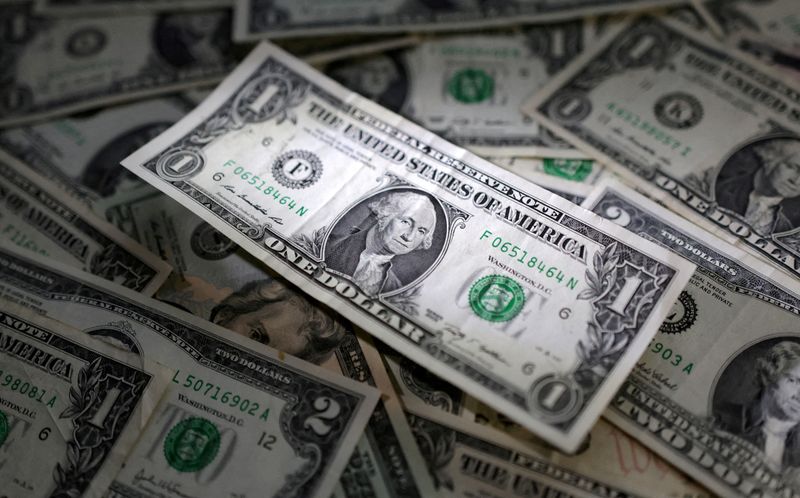 © Reuters. FILE PHOTO: U.S. dollar banknotes are seen in this illustration taken March 10, 2023. REUTERS/Dado Ruvic/Illustration/File Photo
© Reuters. FILE PHOTO: U.S. dollar banknotes are seen in this illustration taken March 10, 2023. REUTERS/Dado Ruvic/Illustration/File Photo
By Saqib Iqbal Ahmed
NEW YORK (Reuters) -The dollar rose against the euro on Friday after dismal business activity data from around the globe soured risk sentiment and as hawkish comments from central banks added to pressure on riskier currencies.
U.S. business activity fell to a three-month low in June as services growth eased for the first time this year and the contraction in the manufacturing sector deepened, closely watched survey data out Friday showed.
The overall picture, though, indicated U.S. economic growth ticked up a notch in the second quarter even as worries persist that the Federal Reserve's aggressive interest rate increases over the past year will trigger a recession.
Earlier in the session data showed euro zone business growth virtually stalled in June. A downturn in manufacturing deepened, while activity in the bloc's dominant services sector barely expanded, as overall demand fell for the first time since January.
"We're starting to see signals from businesses that the demand is starting to ease up at the margin and that's leading to recalibration of expectations of what future output looks like," said Bipan Rai, North America head of FX strategy at CIBC Capital Markets.
"I do think that the concern with the future outlook is weighing on risk appetite right now and the dollar is catching somewhat bid off of that," Rai said.
The euro fell 0.57% to $1.08925, a three-day low against the U.S. dollar. The dollar index, which measures the currency against six rivals, rose 0.49% to 102.89.
Traders squaring books as the end of the month and the quarter nears was also likely supporting the U.S. currency, Rai said.
Friday's data arrived after rate hike surprises and hawkish comments from central banks globally which have renewed market fears that policymakers have further to go in tightening policy to tame inflation, even at the risk of tipping their economies into a recession.
"After bigger than expected rate hikes in the UK and Norway yesterday, the markets are nervous about upside rate surprises, and that was helping the dollar overnight, even before we saw the European PMI data," Kit Juckes, chief FX strategist at Societe Generale (OTC:SCGLY), said in a note.
Fed Chair Jerome Powell said on Thursday the central bank would move interest rates at a "careful pace" from here, but ruled out interest rate cuts "happening any time soon."
Against the yen, the dollar was up 0.44% at 143.76 yen, its strongest level in more than seven months. The Japanese currency has come under renewed pressure as the Bank of Japan (BOJ) maintains an ultra-dovish stance.
Data out on Friday showed that Japan's core consumer inflation exceeded forecasts in May and an index excluding fuel costs rose at the fastest annual pace in 42 years, putting pressure on the BOJ to phase out its massive stimulus.
The pound was down 0.30% on Friday at $1.271, on pace to finish the week down about 1%, its largest weekly loss in six weeks.
The British currency has come under pressure from rising expectations the UK economy could slip into recession after the Bank of England on Thursday delivered an outsized rate hike in response to persistent inflation.
The Australian and New Zealand dollars struggled on Friday as traders avoided riskier currencies.
The Aussie fell 1.16% to $0.6678 and was headed for a weekly loss of nearly 3%, its worst week since late August. The kiwi slid 0.62% to $0.6139, down about 1.6% for the week.
In cryptocurrencies, bitcoin rose 3.46% to a 1-year high of $30,924, on pace for a near 17% gain for the week, its best weekly gain since mid March, boosted by BlackRock (NYSE:BLK)'s plan to create a bitcoin exchange-traded fund.

